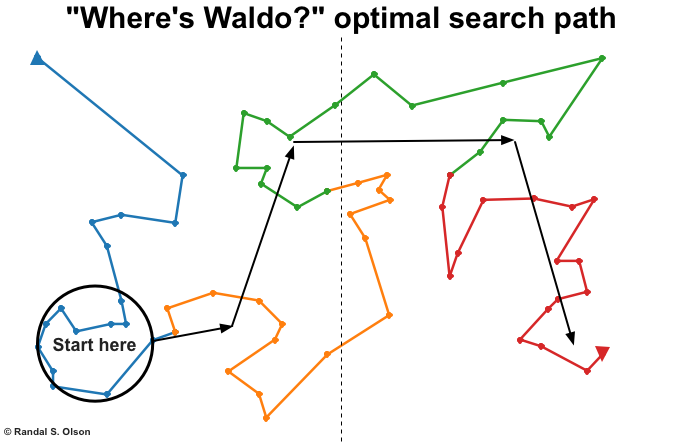Where's Wally? Don't worry, a new algorithm can now tell you exactly how to find him in the shortest time possible.
Developed by Randal Olson, doctoral student at Michigan State University in the US, the algorithm was created using data collected from all 68 of Martin Handford's Where's Wally? books, or Where's Waldo?, as they're called in the US and Canada.
And although it's awesome, it's a tiny bit of a buzzkill for those who remember the frustrating pleasure of staring at a single page for hours on end, trying to find that little spectacled man, and then having your sister walk up behind you and spot him straight away.
Olson first started working on the algorithm while trapped at home during a snow storm last weekend.
"I was going to pull out every machine learning trick in my tool box to compute the optimal search strategy for finding Waldo. I was going to crush Slate's supposed foolproof strategy and carve a trail of defeated Waldo-searchers in my wake," he wrote on his blog.
To do this, he inputted all his data on the location of Wally into a genetic algorithm (GA), which mimics natural selection to find the most efficient method of doing something by trialling something slightly different over and over again. This helped him to optimise the fastest route that someone's eye should take across the page to find Wally, which you can see below.

The algorithm also came up with a few helpful tips for all those Wally-watchers out there desperate to find him quickly.
- The bottom of the left page is a good place to start. If Wally isn't on the bottom half of the left page, then he's probably not on the left page at all.
- The upper quarter of the right page is the next best place to look. Wally seems to prefer to hide on the upper quarter of the right page.
- Next check the bottom right half of the right page. Wally also has an aversion to the bottom left half of the right page. Don't bother looking there until you've exhausted the other hot spots.
Olson is yet to test the algorithm-prescribed path in "This path represents one of the shortest possible paths to follow on the page to find Waldo, so if we followed this path exactly, we'd most likely find Waldo much faster than someone following a more basic technique," Olson wrote.
You can read his blog entry on the topic to find out more about the ideal Wally-solving steps.
But while we love that computers can make our lives more efficient, sometimes we we miss the freedom of wasting time, just a little bit.
And so does Olson, it seems. Over on his blog he concluded:
"This was all done in good humour and - barring a situation where someone puts a gun to your head and forces you to find Waldo faster than their colleague - I don't recommend actually using this strategy for casual Where's Waldo? reading. As with so many things in life, the joy of finding Waldo is in the journey, not the destination."
But if you do want to get competitive, computers can also help you solve rock, paper, scissors and Texas hold 'em poker too.
Sources: The Guardian, Randal Olson
